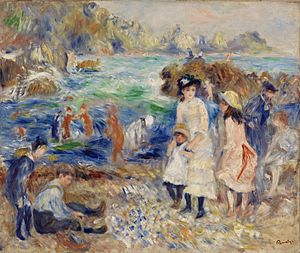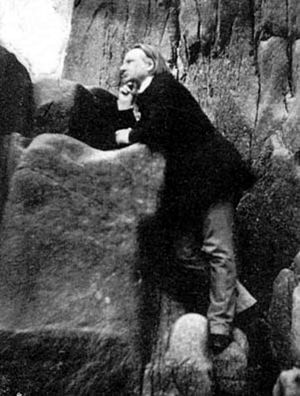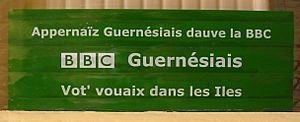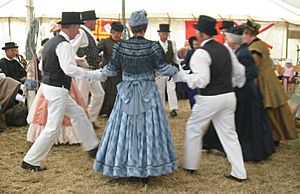Culture of Guernsey facts for kids

The culture of Guernsey is all about the special ways of life, traditions, and history of the island of Guernsey. This culture has been shaped by its own local language, Guernésiais, and old traditions. It also has strong influences from French (especially from Normandy) and British (especially English) ways. Over time, new ideas and traditions have also come from people who moved to Guernsey, like the Portuguese community.
Contents
Guernsey's Special Symbols
Guernsey has some cool symbols that represent the island. These include animals, a flower, and even a special song!
Animal Symbols
The national animals of Guernsey are the donkey and the Guernsey cow.
- The Donkey: People often call Guernsey residents "donkeys" (or ânes in French). This nickname might come from how steep the streets are in St Peter Port, the capital. Donkeys were very useful for carrying things up and down these hills. It also hints that Guernsey people are known for being a bit stubborn, like a mule!
- The Guernsey Cow: This cow is famous around the world! It's known for its rich, creamy milk, which some people think is extra healthy. Guernsey cows are also raised for their tasty beef. Even though fewer islanders raise them now, you can still see these cows grazing in places like L'Ancresse common.
- The Golden Guernsey Goat: This special goat has a beautiful golden coat. After World War II, there were very few Golden Guernsey goats left. Thanks to one woman, Miss Miriam Milbourne, this breed was saved! It's still on a "Watch List" to make sure it stays safe.
Other Island Symbols
- The Guernsey Lily: This beautiful flower, Nerine sarniensis, is another symbol of the island. Sarnia is an old Latin name for Guernsey.
- "Sarnia Cherie": This song is used as Guernsey's anthem for special events.
- Liberation Day: Every year on May 9th, Guernsey celebrates Liberation Day. This day marks the end of the German occupation in 1945 and is a very important celebration for the islanders.
Tasty Food and Drinks
Guernsey has its own delicious traditional foods that you might want to try!
Traditional Dishes
- Guernsey gâche: This is a rich fruit bread, perfect for a snack.
- Gâche mêlaïe: An apple pudding that's a sweet treat.
- "Bean Jar": This is a hearty dish, a bit like a cassoulet, made with pork and beans. It's a very comforting meal.
- Conger Soup: A soup made from conger eel.
Seafood Delights
Because Guernsey is an island, seafood is very popular!
- Ormer: This is a local specialty, a type of abalone. People collect them from the beaches when the tide is very low.
- You can also find fresh spider crabs, mussels, and lobster, which are all very popular.
Languages of Guernsey
While English is the main language spoken by most people in Guernsey today, the island has a rich language history.
Guernésiais
The traditional language of Guernsey is Guernésiais. It's a type of Norman language, similar to old French. In 2001, only about 2% of the population spoke it fluently. However, more people (about 14%) understand some of it, and it's even taught in some schools. Many old family names and place names on the island come from this language. For example, "hougue" means hill, and "vraic" means a type of seaweed.
Other Languages
- French: Until the early 1900s, French was the official language of Guernsey.
- Portuguese: Today, Portuguese is also spoken by about 2% of the population and is taught in some schools, reflecting the island's diverse community.
Famous Writers and Books
Guernsey has inspired many writers, including a very famous one!

- Victor Hugo: The famous French writer Victor Hugo lived in Guernsey when he was in exile. He wrote some of his most well-known books here, including Les Misérables. His house in St Peter Port, Hauteville House, is now a museum. In 1866, he wrote a novel called Travailleurs de la Mer (Toilers of the Sea), which was set on the island and dedicated to Guernsey.
- The Book of Ebenezer Le Page: This popular novel by GB Edwards is about life in Guernsey during the 20th century. It's a great way to learn about the island's past.
- Local Poets: George Métivier is often called Guernsey's national poet, and he wrote in Guernésiais. Other important Guernésiais writers include Denys Corbet, Tam Lenfestey, T. H. Mahy, and Marjorie Ozanne.
Old Ways of Measuring
Guernsey used to have its own special ways of measuring things, which were different from those in England!
Land Area
- A vergée (or vergie in Guernésiais) is a way to measure land. It's about 1,639 square meters (or 17,640 square feet).
- A Guernsey perch (or perque) is a smaller measurement, equal to 21 feet by 21 feet.
Money
- For many years, Guernsey had its own coins called doubles. Eight doubles made one Guernsey penny.
- Later, British coins became legal to use on the island.
Media and News
Guernsey has its own radio stations, TV channels, and a newspaper to keep everyone informed and entertained.
Radio and TV
- Radio: You can listen to two local radio stations: BBC Guernsey and Island FM.
- Television: Guernsey shares a local ITV channel called ITV Channel Television with the other Channel Islands. They have their own daily news show, ITV News Channel TV. The BBC also broadcasts news for the Channel Islands as part of its Spotlight program. Because Guernsey is close to France, you can often watch French TV channels too!
Newspaper
- The Guernsey Press and Star is the daily newspaper for the island, keeping everyone up-to-date on local news.
Music and Dance
Music and dance have a long history in Guernsey, though some traditions changed over time.
- Traditional Music: In the past, some religious changes led to less dancing and secular music. However, some traditional songs and dances have been recorded and are still performed today. Songs like Jean, Gros Jean and J'ai perdu ma faumme are examples.
- Folk Groups: Groups like La Guaine du Vouêt and Les Dànsaeurs dé L'Assembllaïe D'Guernésiais perform traditional dances and songs at local events.
- Modern Music: Guernsey has also hosted a big music event called Guernsey Live, which was one of the largest music festivals in the Channel Islands.
- Music Education: The island is known for its excellent music teaching, which helps many young people become talented musicians.
Sports on the Island
Guernsey loves sports and competes in many events, often with its own teams!
- Commonwealth Games: Guernsey has its own team that competes in the Commonwealth Games.
- Island Games: Guernsey also takes part in the Island Games, which it has hosted twice, in 2003 and 2023.
- Choosing a Team: If islanders are very good at a sport but Guernsey doesn't have its own international team, they can sometimes choose to play for one of the British Home Nations (like England or Scotland). For example, the famous football player Matt Le Tissier played for England.
- Island Colors: The traditional color for Guernsey sports teams is green.
- Rivalries: There's a friendly rivalry between Guernsey and Jersey in sports!
- The Muratti match is an annual football game between Guernsey and Jersey, which started in 1905.
- The Siam Cup is a rugby match that has been played between the two islands since 1920.
- Local Teams: Both Guernsey F.C. (football) and Guernsey RFC (rugby) play in English leagues. Women's rugby and football teams also compete in English leagues.
- Cricket: The Guernsey Cricket Board is part of the International Cricket Council (ICC), and the Guernsey cricket team plays in world cricket events.
Gallery
-
Little Chapel, Les Vauxbelets, Guernsey
See also
 In Spanish: Cultura de Guernsey para niños
In Spanish: Cultura de Guernsey para niños






